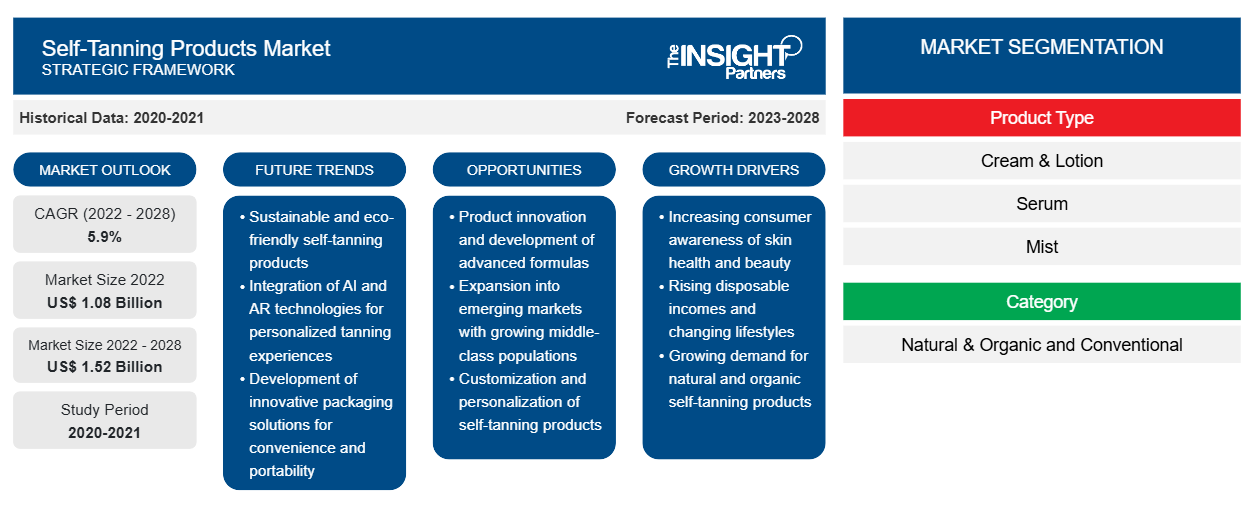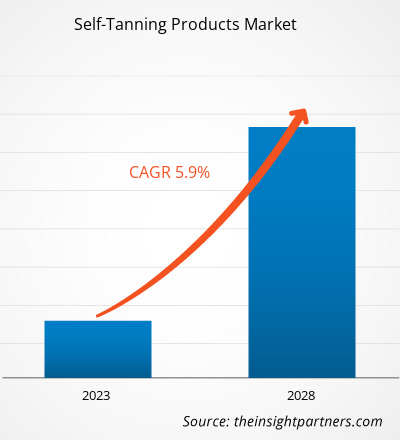The self-tanning products market size is expected to grow from US$ 1,078.36 million in 2022 to US$ 1,519.59 million by 2028; it is estimated to register a CAGR of 5.9% from 2022 to 2028.
Self-tanning products, also known as sunless tanning products or fake tanners, are used to get a tanned or bronzed skin tone without direct exposure to sunlight. The harmful UV rays of sunlight can cause potential skin damage and increase the risk of skin cancers. This factor is significantly driving the demand for self-tanning products. Moreover, a rising number of celebrities embracing a tanned look is also expected to boost the adoption of self-tanning products, especially among young consumers.
In 2021, Europe held the largest share of the global self-tanning products market. The changing trends in consumer lifestyle and skincare routine are driving the self-tanning products market in Europe. The wellness industry in the region is gradually adapting to evolving consumer choices such as organic and natural products. Thus, manufacturers are increasingly using natural ingredients to develop self-tanning products. These factors are influencing the self-tanning products market. Moreover, the growing trend to attain a natural and glowing tan, especially in young adults, is anticipated to boost the sales of self-tanning products during the forecast period.
Customize This Report To Suit Your Requirement
You will get customization on any report - free of charge - including parts of this report, or country-level analysis, Excel Data pack, as well as avail great offers and discounts for start-ups & universities
Self-Tanning Products Market: Strategic Insights

-
Get Top Key Market Trends of this report.This FREE sample will include data analysis, ranging from market trends to estimates and forecasts.
Impact of COVID-19 Pandemic on Self-Tanning Products Market
The COVID-19 pandemic had a mixed impact on the self-tanning product market, especially in 2020. Self-tanning products were not classified as essential products by governments of several countries, which compelled manufacturers to halt the production of these products. During the crisis, service providers in the tanning salon industry witnessed a massive setback due to the reduced demand for tanning products. However, the COVID-19 pandemic triggered a digital transformation across many industries, including cosmetic & personal care. According to data released by Bluecore, an average increase of 127% was reported in the online sale of beauty and skincare products globally in June 2020, compared to the same month in 2019. Similarly, L’Oréal reported that its sales through online channels grew from 15.6% in 2019 to 26.6% in 2020. These factors show a mixed impact of the pandemic on the self-tanning products market.
In 2021, various economies resumed operations as their governments announced relaxations in the previously imposed restrictions, which boosted the global marketplace. Further, manufacturers were permitted to operate at full capacities, which helped them overcome the demand and supply gap and other repercussions. Currently, the market situation is stable, and manufacturers are expanding their presence on online retail platforms such as Amazon.com, Shopify, Walmart, and ebay to boost their sales. This factor is expected to drive the growth of the self-tanning products market over the forecast period.
Market Insights
Growth of Global Cosmetic Industry
In recent times, health and skin care awareness has increased significantly across the globe. The increase in developments in sustainable cosmetics, advertising strategies, and innovative product branding are the major factors responsible for establishing the cosmetic industry. Also, the rise in health concerns about skin diseases and other health risks associated with environmental and sun exposure has increased the demand for cosmetic product offerings. Women are increasingly adding grooming products into their daily routines. The cosmetics market in Europe and North America is well established, whereas the cosmetic industry is significantly growing in Asia Pacific and the Middle East & Africa. With the rising number of product launches, consumers can choose from multiple brands available in the market. As per the data published in L'Oréal's 2020 annual report, the global beauty markets witnessed a growth rate of 8% in 2019. Thus, the rising expenditure on beauty products aids in the growth of the global cosmetic industry. Self-tanning products are becoming increasingly popular as people are fond of bronze and tanned skin tones. Also, these products are convenient to use as they impart desired skin tone without sun exposure and sun damage. Thus, the growth of the cosmetics industry across the globe and the increased use of self-tanners are driving the self-tanning products market.
Product Type-Based Insights
Based on product type, the global self-tanning products market is segmented into cream & lotion, serum, mist, and others. The cream & lotion segment held the largest share of the global self-tanning products market in 2021; however, the mist segment is expected to register the highest CAGR from 2022 to 2028. A self-tanning mist contains a water-based tanning formulation, making it convenient for application. It consists of a 360-degree wide-angle jet applicator that completes and evenly distributes the product across the face and dries instantly due to light consistency. Customers prefer self-tanning mist for touch-up purposes as well. Therefore, owing to the primary advantage of its hassle-free application, the mist segment is gaining popularity among many consumers across the globe.
Distribution Channel-Based Insights
Based on distribution channel, the global self-tanning products market is segmented into supermarkets & hypermarkets, convenience stores, online retail, and others. The supermarkets & hypermarkets segment held the largest share of the global self-tanning products market in 2021; however, the online retail segment is expected to register the highest CAGR from 2022 to 2028. Online retail stores offer various products with heavy discounts. Also, consumers can conveniently buy desirable products remotely. Furthermore, home delivery services attract a large group of customers to shop through e-commerce platforms such as Amazon.com, Walmart, and E-bay. Moreover, these websites offer descriptive product information and user reviews, which helps buyers compare products and make informed decisions. During the COVID-19 pandemic, online retail channels became popular as they offered home delivery services. Owing to all these factors, online retail is one of the fastest-growing distribution channels.
A few players operating in the global self-tanning products market include Bondi Sands Pty Ltd, KAO Corp, PZ Cussons Plc, Supernova UK Pty Ltd, Epic Etailers LLC, Loreal SA, HotHouse Beauty Ltd, Johnson & Johnson, Coty Inc, and Edgewell Personal Care Co. Market players are focusing on providing high-quality products to fulfill customer demand. They are also focusing on strategies such as investments in research and development activities and mergers & acquisitions.
Report Spotlights
- Progressive industry trends in the self-tanning products market to help players develop effective long-term strategies
- Business growth strategies adopted by developed and developing countries
- Quantitative analysis of the self-tanning products market from 2020 to 2028
- Estimation of global demand for self-tanning products
- PEST analysis to illustrate the political, economic, social, and technological factors impacting the global self-tanning products market growth.
- Recent developments to understand the competitive market scenario
- Market trends and outlook, as well as factors driving and restraining the growth of the self-tanning products market
- Assistance in decision-making process by highlighting market strategies that underpin commercial interest, leading to the market growth
- Self-tanning products market size at various nodes
- Detailed overview and segmentation of the market, as well as the self-tanning products’ industry dynamics
- Size of the self-tanning products market in various regions with promising growth opportunities
The regional trends and factors influencing the Self-Tanning Products Market throughout the forecast period have been thoroughly explained by the analysts at The Insight Partners. This section also discusses Self-Tanning Products Market segments and geography across North America, Europe, Asia Pacific, Middle East and Africa, and South and Central America.
Self-Tanning Products Market Report Scope
| Report Attribute | Details |
|---|---|
| Market size in 2022 | US$ 1.08 Billion |
| Market Size by 2028 | US$ 1.52 Billion |
| Global CAGR (2022 - 2028) | 5.9% |
| Historical Data | 2020-2021 |
| Forecast period | 2023-2028 |
| Segments Covered |
By Product Type
|
| Regions and Countries Covered |
North America
|
| Market leaders and key company profiles |
|
Self-Tanning Products Market Players Density: Understanding Its Impact on Business Dynamics
The Self-Tanning Products Market is growing rapidly, driven by increasing end-user demand due to factors such as evolving consumer preferences, technological advancements, and greater awareness of the product's benefits. As demand rises, businesses are expanding their offerings, innovating to meet consumer needs, and capitalizing on emerging trends, which further fuels market growth.

- Get the Self-Tanning Products Market top key players overview
Company Profiles
- Bondi Sands Pty Ltd
- KAO Corp
- PZ Cussons Plc
- Supernova UK Pty Ltd
- Epic Etailers LLC
- Loreal SA
- HotHouse Beauty Ltd
- Johnson & Johnson
- Coty Inc
- Edgewell Personal Care Co
Frequently Asked Questions
What are the key drivers for the growth of the global self-tanning products market?
Based on distribution channel, which segment is projected to grow at the fastest CAGR over the forecast period?
Based on product type, why does the creams & lotions segment have the largest revenue share?
What is the largest region of the global self-tanning products market?
What are the opportunities for self-tanning products in the global market?
Can you list some of the major players operating in the global self-tanning products market?
- Historical Analysis (2 Years), Base Year, Forecast (7 Years) with CAGR
- PEST and SWOT Analysis
- Market Size Value / Volume - Global, Regional, Country
- Industry and Competitive Landscape
- Excel Dataset
Recent Reports
Testimonials
Reason to Buy
- Informed Decision-Making
- Understanding Market Dynamics
- Competitive Analysis
- Identifying Emerging Markets
- Customer Insights
- Market Forecasts
- Risk Mitigation
- Boosting Operational Efficiency
- Strategic Planning
- Investment Justification
- Tracking Industry Innovations
- Aligning with Regulatory Trends





















 Get Free Sample For
Get Free Sample For